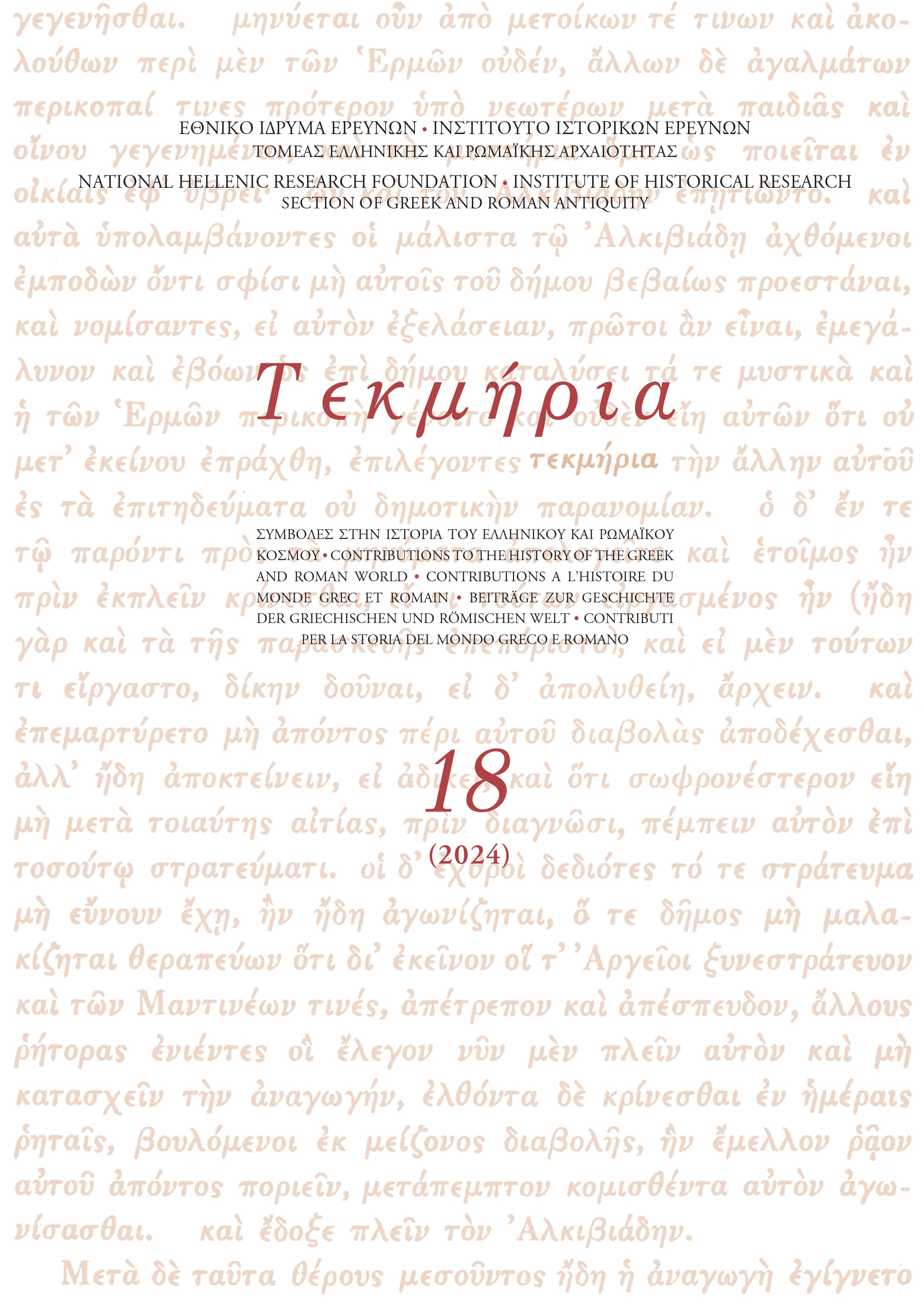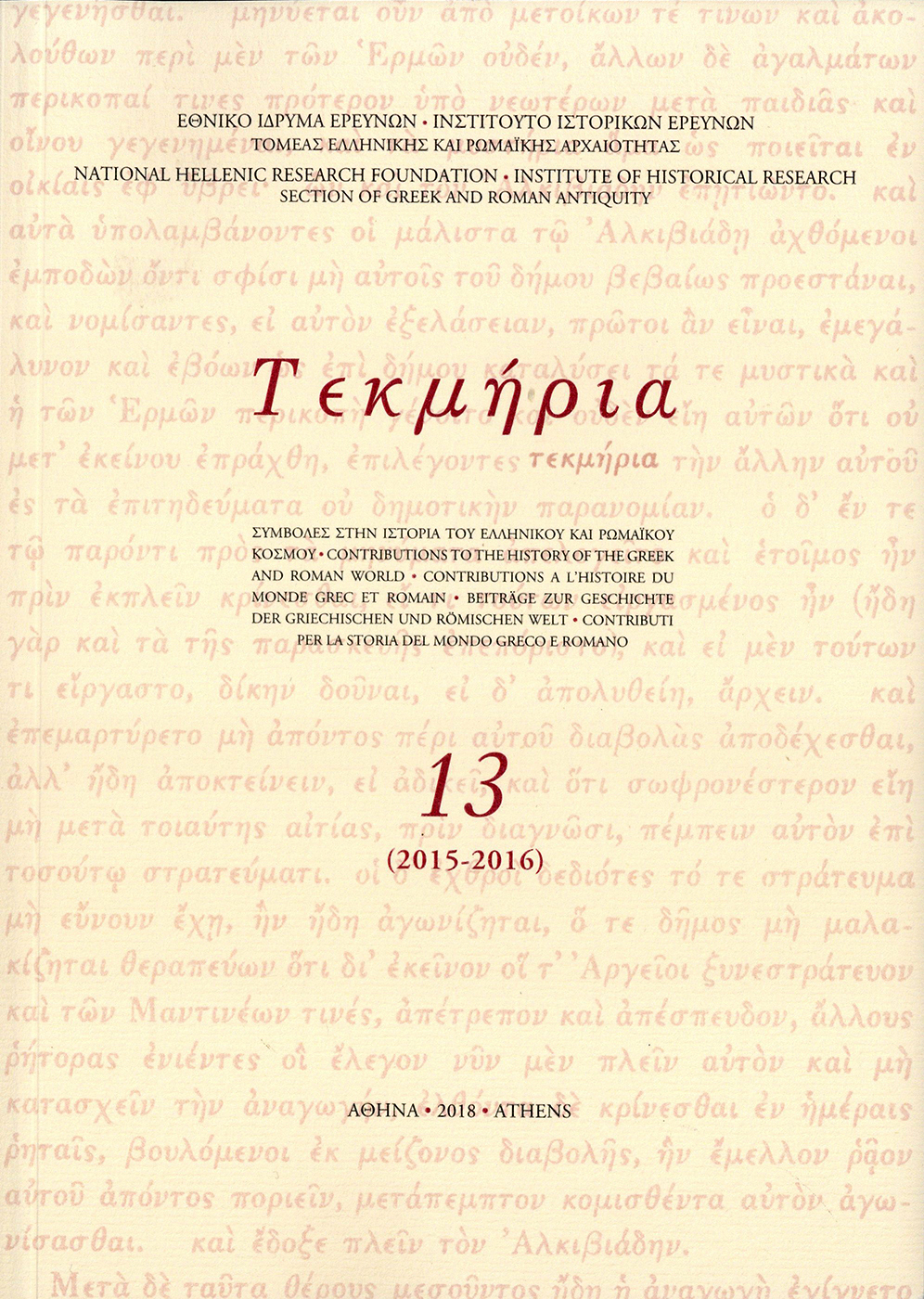The “Tomb of the Philosophers” in Pella, Macedonia Revisited: New Findings on Its Iconography
Περίληψη
This article discusses the new findings on the iconography of the two figural friezes painted in the interior of the “Tomb of the Philosophers”, an early Hellenistic, monumental, built cist grave, situated in the east cemetery of Pella, Macedonia. A new technical investigation of the tomb’s wall paintings has allowed the revision of older readings of the two friezes. In the lower, main figural frieze new observations pertain to figure characterization, through features, dress and attributes, as well as to the scene’s setting. The figures of the frieze offer the earliest preserved gathering of intellectuals whose professional insignia cannot be missed, while the celestial globe shown on the west wall appears to be one of the earliest extant representations of the device and the earliest preserved in a funerary environment. The new identification proposed for the monuments shown in the upper, secondary frieze, which represents a horse race, aligns the frieze’s composition with established iconographic schemes of agonistic events, adds multiple levels of symbolism, and ties the Pella wall-paintings more tightly than previously believed with the “Torre Annunziata philosopher mosaic”, Pompeii, and its twin from Sarsina, Umbria. The bonds of astronomy/cosmology with political theory and with aspects of Macedonian royal ideology, in particular, are set in relief. Finally, it is argued that the physical vicinity of the “Tomb of the Philosophers” with the palace of Pella and the royal court informed the mode of burial of a man of thought with favourable relations to his times’ monarchy, as well as his mode of portrayal as “the astronomer” on the west wall, a figure that presents us with a Macedonian iconographic hybrid of a philosopher, resonating the Platonic concept of the “philosopher king”.
Λεπτομέρειες άρθρου
- Πώς να δημιουργήσετε Αναφορές
-
Kalaitzi, M., Brecoulaki, H., & Verri, G. (2024). The “Tomb of the Philosophers” in Pella, Macedonia Revisited: New Findings on Its Iconography. Τεκμήρια, 18, 97–150. https://doi.org/10.12681/tekmeria.36631
- Τεύχος
- Τόμ. 18 (2024)
- Ενότητα
- Άρθρα

Αυτή η εργασία είναι αδειοδοτημένη υπό το CC Αναφορά Δημιουργού – Μη Εμπορική Χρήση – Παρόμοια Διανομή 4.0.
Οι συγγραφείς των άρθρων που δημοσιεύονται στα Τεκμήρια διατηρούν τα δικαιώματα πνευματικής ιδιοκτησίας επί των άρθρων τους, παραχωρώντας στο περιοδικό το δικαίωμα της πρώτης δημοσίευσης. Άρθρα που δημοσιεύονται στα Τεκμήρια μπορούν να χρησιμοποιούνται ελεύθερα για μη κερδοσκοπικούς σκοπούς, χωρίς δικαίωμα τροποποίησης (δημιουργία παράγωγου έργου), με αναφορά στο συγγραφέα και στην πρώτη δημοσίευση. Το Εθνικό Ίδρυμα Ερευνών διατηρεί το δικαίωμα να δημοσιεύει, να αναπαράγει, να παρουσιάζει στο κοινό, να διανέμει και να χρησιμοποιεί άρθρα που δημοσιεύονται στα Τεκμήρια σε οποιοδήποτε μέσο και μορφή, είτε μεμονωμένα είτε ως μέρη συλλογικών έργων, για όλο το χρόνο διάρκειας προστασίας της πνευματικής ιδιοκτησίας και για όλες τις χώρες του κόσμου. Αυτό περιλαμβάνει, ενδεικτικά και όχι αποκλειστικά, το δικαίωμα δημοσίευσης των άρθρων σε τεύχη του περιοδικού Τεκμήρια, αναπαραγωγής και διανομής μεμονωμένων αντιγράφων των άρθρων, αναπαραγωγής ολόκληρων των άρθρων σε άλλη έκδοση του ΕΙΕ, και αναπαραγωγής και διανομής των άρθρων ή της περίληψης τους με χρήση πληροφορικού συστήματος αποθετηρίου.




